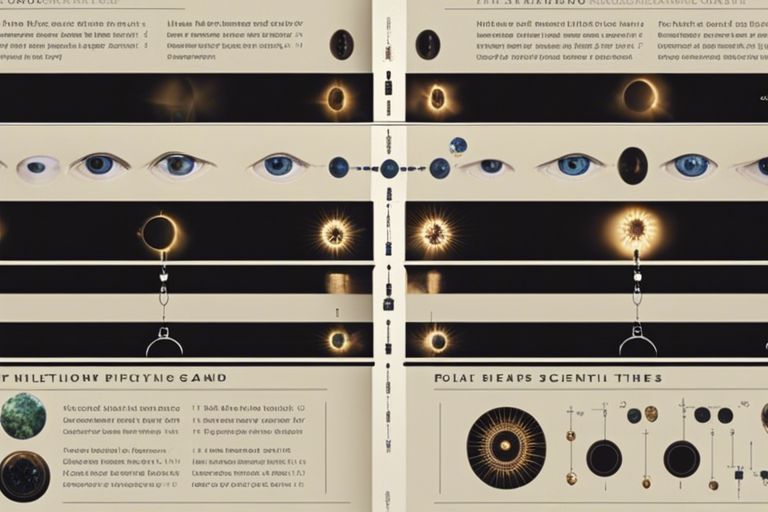There’s a fascinating journey throughout history that traces the scientific understanding of the pineal gland. From its mystical associations in ancient times to Descartes’ groundbreaking views, and modern research shedding new light on its functions, your exploration of this small but mighty gland will unveil a captivating story of scientific evolution. Join us as we examine into the rich history and evolving perspectives on the pineal gland.
Key Takeaways:
- Ancient beliefs: The pineal gland was historically considered the “seat of the soul” and connected to spiritual experiences.
- Renaissance period: René Descartes suggested the pineal gland as the physical location of the soul, leading to its study in the context of the mind-body connection.
- Modern science: Scientific understanding has revealed the pineal gland’s role in regulating sleep-wake cycles through melatonin production and its connection to the body’s circadian rhythm.


Ancient Civilizations
Early Beliefs and Mythologies
Before modern scientific understanding, ancient civilizations held mystical beliefs about the pineal gland. In many cultures, including ancient Egypt and Mesopotamia, the pineal gland was thought to be a connection to the spiritual realm or higher consciousness. Some believed it to be the seat of the soul, while others considered it a source of intuition and wisdom.
The Pineal Gland in Ancient Greece and Rome
To the ancient Greeks and Romans, the pineal gland was seen as a mysterious and potent gland in the body. The philosopher Aristotle believed it to be the “seat of the soul,” responsible for controlling consciousness and intelligence. Galen, a prominent physician in the Roman Empire, also recognized the importance of the pineal gland, describing it as a regulator of wake-sleep cycles and bodily functions.
For the Greeks and Romans, the pineal gland was a symbol of spiritual insight and understanding. They associated it with the concept of the “third eye,” believed to provide perception beyond ordinary sight. This mystical view of the pineal gland as a source of inner vision and enlightenment persisted throughout antiquity.
The Renaissance and Enlightenment
Descartes and the Seat of the Soul
Renaissance philosopher and mathematician René Descartes played a significant role in shaping our understanding of the pineal gland during the 17th century. Descartes believed that this tiny gland located deep within the brain was the “seat of the soul.” In his view, the pineal gland was where the mind interacted with the body, serving as a connection point between the physical and the spiritual realms.
The Discovery of the Pineal Gland’s Function
Function comes into focus during the Enlightenment period when scientific inquiry took center stage. Through meticulous anatomical studies, researchers like Thomas Willis began to unravel the true function of the pineal gland. While Descartes’ idea of the pineal gland as the seat of the soul was philosophical, Willis and his contemporaries discovered that this small gland actually played a crucial role in regulating circadian rhythms and producing melatonin, a hormone that influences sleep patterns.
Seat While Descartes’ notion of the pineal gland as the seat of the soul may have been more metaphysical, the subsequent discoveries about its actual biological function marked a significant shift in our understanding of this enigmatic gland. The realization that the pineal gland is involved in hormone production and the regulation of our internal body clock laid the foundation for further research into its physiological roles.
The 19th and Early 20th Centuries
All Pineal gland, your journey through scientific understanding takes an interesting turn in the 19th and early 20th centuries. During this period, researchers began to investigate deeper into the functions of this mysterious gland nestled deep within your brain.
The Pineal Gland and Melatonin
With advancements in scientific research, the 19th and early 20th centuries saw the discovery of melatonin, a hormone produced by the pineal gland. Melatonin plays a crucial role in regulating your sleep-wake cycle, also known as the circadian rhythm. This finding shed light on the pineal gland’s role in your overall well-being and its impact on your internal biological clock.
Early Research on the Pineal Gland’s Role
Pineal gland, early researchers in the 19th and early 20th centuries speculated on the pineal gland’s significance beyond melatonin production. Some scientists believed that this small gland could be the seat of the soul or the link between the physical and spiritual worlds. These theories, though fascinating, spurred further scientific investigation into the true functions of the pineal gland.
Early research on the pineal gland’s role also explored its connections to various physiological processes, such as reproductive function, mood regulation, and the body’s response to light. These studies laid the foundation for modern-day understanding of the pineal gland’s multifaceted functions and its intricate involvement in your body’s complex systems.

Mid-20th Century Breakthroughs
The Isolation of Melatonin
Despite many years of research, it wasn’t until the mid-20th century that scientists were able to isolate and identify the hormone produced by the pineal gland: melatonin. In 1958, Aaron B. Lerner and his team at Yale University successfully extracted and characterized melatonin. This discovery was a significant milestone in understanding the pineal gland’s functions and its role in regulating various physiological processes.
The Pineal Gland’s Role in Circadian Rhythms
Any discussion about the pineal gland in the mid-20th century inevitably led to the exploration of its role in circadian rhythms. Scientists uncovered that melatonin, produced by the pineal gland, played a crucial part in regulating the body’s internal clock. Melatonin levels typically rise in the evening, signaling to your body that it’s time to sleep, and decrease in the morning, allowing you to wake up refreshed and ready for the day.
For instance, disruptions in the pineal gland’s production of melatonin, such as those caused by jet lag or shift work, can lead to difficulties in sleeping and waking at the appropriate times. Understanding how the pineal gland influences circadian rhythms has opened up new avenues for research into treating sleep disorders and optimizing human performance based on our biological clock.
Modern Era
Advances in Neuroimaging and Brain Research
Advances in neuroimaging techniques, such as magnetic resonance imaging (MRI) and positron emission tomography (PET), have allowed researchers to study the pineal gland with unprecedented detail in the modern era. These imaging tools have provided insights into the structure, function, and connectivity of the pineal gland in the brain.
The Pineal Gland’s Connection to Psychiatric Disorders
The pineal gland has been implicated in various psychiatric disorders in recent years. Studies have suggested a potential link between the pineal gland and conditions such as depression, schizophrenia, and bipolar disorder. Research in this area is ongoing, aiming to unravel the complex mechanisms underlying these connections.
A better understanding of the pineal gland’s role in psychiatric disorders could lead to the development of novel treatment approaches that target this enigmatic gland. By delving deeper into the interactions between the pineal gland and mental health, researchers may uncover new avenues for therapeutic interventions and improve outcomes for individuals suffering from these conditions.
Contemporary Research and Debates
The Pineal Gland’s Role in Meditation and Spirituality
Not only is the pineal gland being investigated for its biological functions, but it is also gaining attention for its potential role in deeper aspects of human experience. Contemporary research is exploring the connection between the pineal gland and meditation, as well as spirituality. Some scientists hypothesize that the pineal gland might play a role in facilitating altered states of consciousness, which are often associated with spiritual practices.
The Controversy Surrounding DMT and the Pineal Gland
Any discussion of the pineal gland in the modern context invariably involves the controversy surrounding dimethyltryptamine (DMT), a potent psychedelic compound. Some researchers speculate that the pineal gland could produce and release DMT, leading to mystical or near-death experiences. However, this hypothesis is highly debated within the scientific community, with many questioning the evidence and feasibility of such a mechanism.
Pineal gland calcification has been suggested as a factor that could limit the synthesis and release of DMT from the pineal gland. This mineralization process, which increases with age, could potentially hinder the gland’s ability to produce DMT in significant amounts, further adding to the complexity of this ongoing debate.
Final Words
With these considerations, you can see how scientific understanding of the pineal gland has evolved over time, from ancient beliefs in its mystical powers to modern medical knowledge about its role in regulating hormones and circadian rhythms. It is fascinating to see how centuries of research and discoveries have gradually demystified the pineal gland, shedding light on its crucial functions in the human body.
As our understanding continues to deepen, the pineal gland remains a subject of ongoing research and intrigue, offering insights into both the biological mechanisms of the body and the historical development of scientific knowledge. The journey of discovery surrounding this small but significant gland serves as a reminder of the complexities of the human body and the ever-evolving nature of scientific understanding.
Q: What is the historical understanding of the pineal gland?
A: In ancient times, the pineal gland was believed to be the seat of the soul or the “third eye” due to its central location in the brain. This mystical view persisted through the Renaissance period, with philosophers like René Descartes suggesting that the pineal gland was where the mind interacted with the body.
Q: How has scientific understanding of the pineal gland evolved?
A: In the 20th century, scientific research revealed that the pineal gland is responsible for producing the hormone melatonin, which regulates sleep-wake cycles and plays a role in seasonal biological rhythms. This shift in understanding emphasized the pineal gland’s physiological functions rather than its mystical properties.
Q: What is the current scientific understanding of the pineal gland?
A: Today, scientists continue to study the pineal gland and its role in various physiological processes, including circadian rhythms, sexual development, and the regulation of mood. Research also explores the potential impact of light exposure on the pineal gland’s function and how disruptions in melatonin production may affect overall health.


